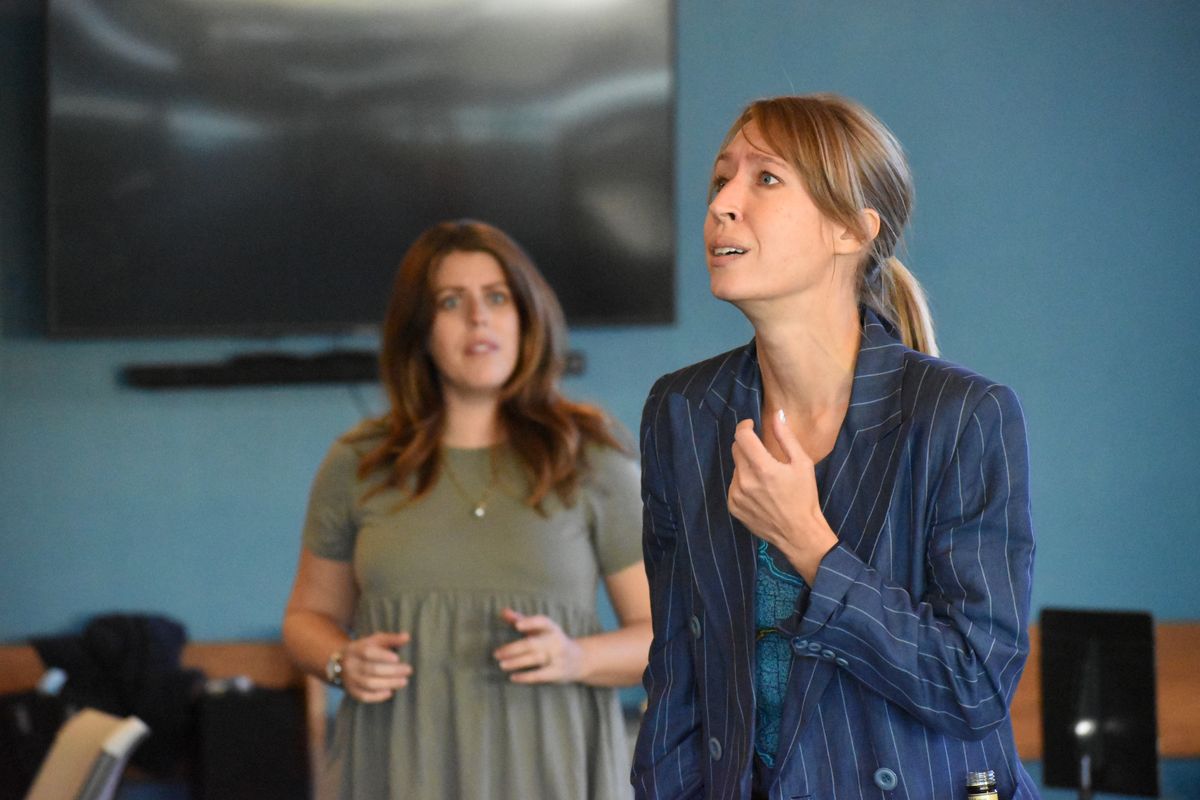Inland Northwest Opera’s ‘Orpheus and Eurydice’: ‘There’s something for everybody in this production’

Set in a 1950s “Mad Men”-era dreamscape, Inland Northwest Opera’s all-new production of Christoph Gluck’s “Orpheus and Eurydice” reimagines Orpheus, the hapless hero, as a musician mourning the loss of his lover.
Sung in Italian with English subtitles, the show takes the stage at Martin Woldson Theater at the Fox at 7:30 p.m. Friday and 3 p.m. Sunday. The production, including dress rehearsals, will also be filmed and available to view online.
When tragedy separates Orpheus (Emily Fons) – a “pants role,” or male role played by a female singer – from his beloved wife Eurydice (Emily Birsan), the distraught young man strikes a bargain with Amore (Jocelyn Claire Thomas), a mysterious figure who promises Orpheus a second chance.
The show may be titled “Orpheus and Eurydice,” but the real puppetmaster in INO’s production is Amore.
In the original, Amore appears to lay out the parameters of Orpheus’ task and show him the way – but only reappears again near the end to undo his mistakes.
“But in this version, Amore is not really this sweet, nice character who saves the day,” Thomas said.
Instead, Amore appears as a sort of 1950s femme fatale, pulling strings at every step.
“I’m basically onstage the whole show … essentially everything that happens is by design, in the sense that I’m putting Orpheus through this … almost for my own amusement,” she said.
We meet the grieving artist in a bar where, presumably, he and Eurydice first met. Reminiscing with his friends, Orpheus’ mood darkens as he gives himself over to grief. Soon after, the figure of Amore appears with a proposition. Vulnerable as Orpheus is, Amore eventually convinces Orpheus to go.
Descending into the underworld with Amore’s help, Orpheus resolves to bring Eurydice back, but there’s a catch. He must convince her to follow without speaking.
Throughout the show, Orpheus is besieged by a series of trials and shadowy figures portrayed by dancers. The dancing cast includes Gonzaga Dance students Ryan Hayes, Brooke Geffrey-Bowler, Alaina Margo and Maria Scott and professional fire dancers Leslie Rosen and Chelsea Kyger.
“That’s one of the coolest things about this production … these two fire dancers,” Thomas said, mentioning how exciting their first full tech rehearsal had been finally getting to see the performers dance with real fire onstage.
The fire dancers appear almost as servants to Amore, bringing her cocktails and the occasional stage cigarette. The cigarette holder is always a great prop, Thomas explained, but the sort of breathing acrobatics that a vocalist has to go through to sing and smoke at the same time are on another level.
At a couple of points, the direction calls for her to exhale the smoke (water vapor) and sing at the same time.
“Which means that I can’t actually inhale in the normal way that I would if I was just going to sing a phrase,” she said. “I have to inhale through my nose, hold my breath and then suck the smoke into my mouth so that it all comes together when I exhale while I’m singing.”
Luckily, for an opera singer, thinking about breathing and air is already a constant process, Thomas said. And now especially with COVID-19 and all the respiratory concerns associated with the virus.
“Inland Northwest Opera has been really amazing about testing everybody regularly, masking and making sure you don’t go to rehearsal until you’ve received your negative test,” she said.
“It’s a little bit scary being a singer because not only am I someone who maybe expels more than the normal share of aerosols because that’s literally what I’m doing, making my voice carry.
“But also, if I were to get sick, it’s extra scary because a respiratory disease could potentially end my career. So, I felt very safe and well taken care of … they’re being hyper cautious and vigilant.”
Getting back up onstage after more than a year without full-length live performances has been emotional and rewarding, she said. In a recent rehearsal, she realized that she has missed listening to the orchestra just as much as singing. Her favorite part of the score is a flute solo in an instrumental section.
“It’s called ‘the Dance of the Blessed Spirits,’ ” she said. “It’s just this really beautiful moment between two of the dancers and the flute player in the orchestra.
“The first time we heard the orchestra was one of the most emotional moments for me – it had been such a long time, and it really kind of hit me at that moment.”
Thomas hopes that audience members go away with a similar sense of wonder.
“The cool thing about opera, what really makes it stand out from all the art forms, is that it encompasses all art forms,” she said. “There’s music, instrumental and vocal. There’s theater. There’s visual art, sets and costumes and dancing.
“As an opera singer, I’m constantly trying to battle against the idea that opera is boring or an outdated thing. But there’s something for everybody in this production.”